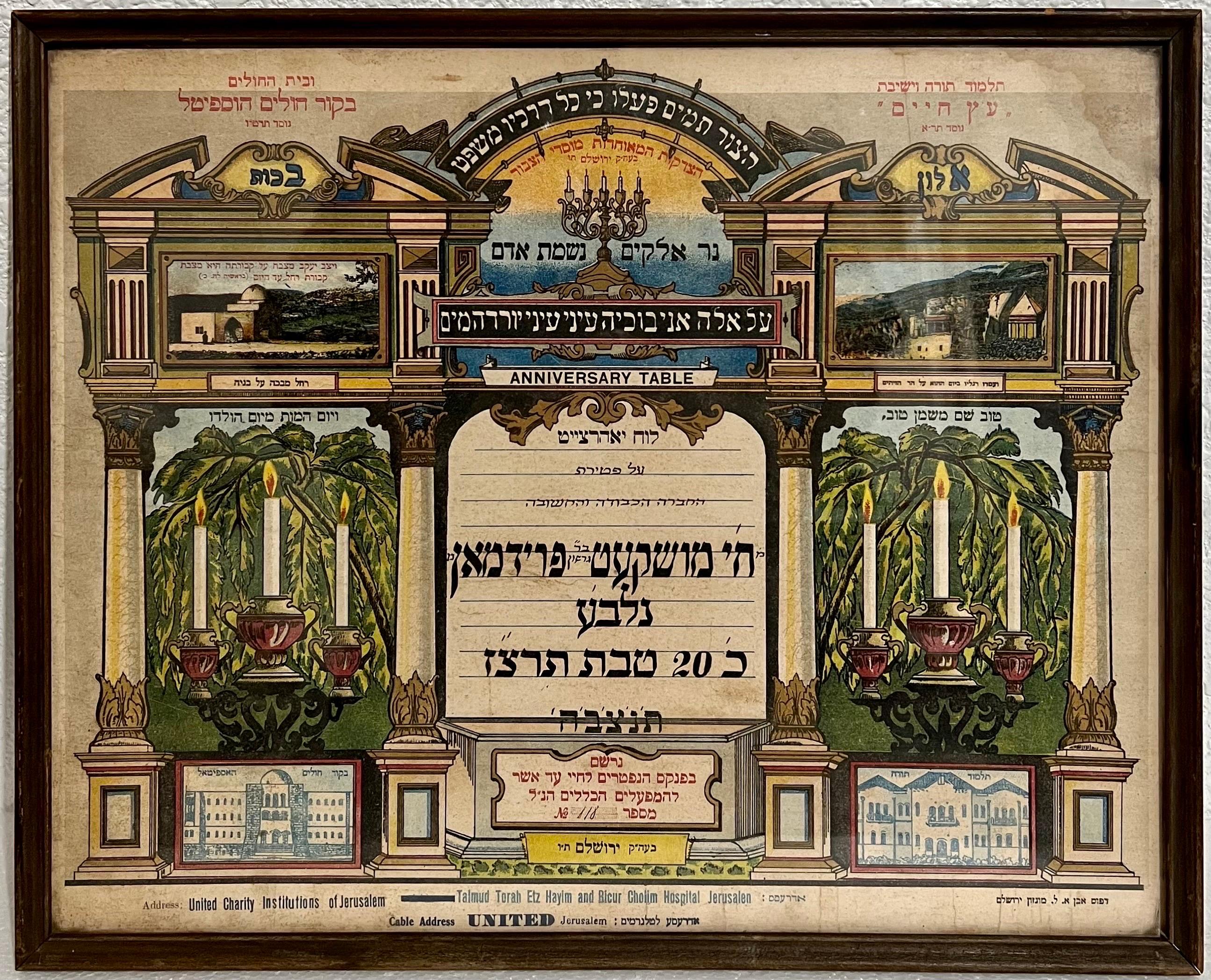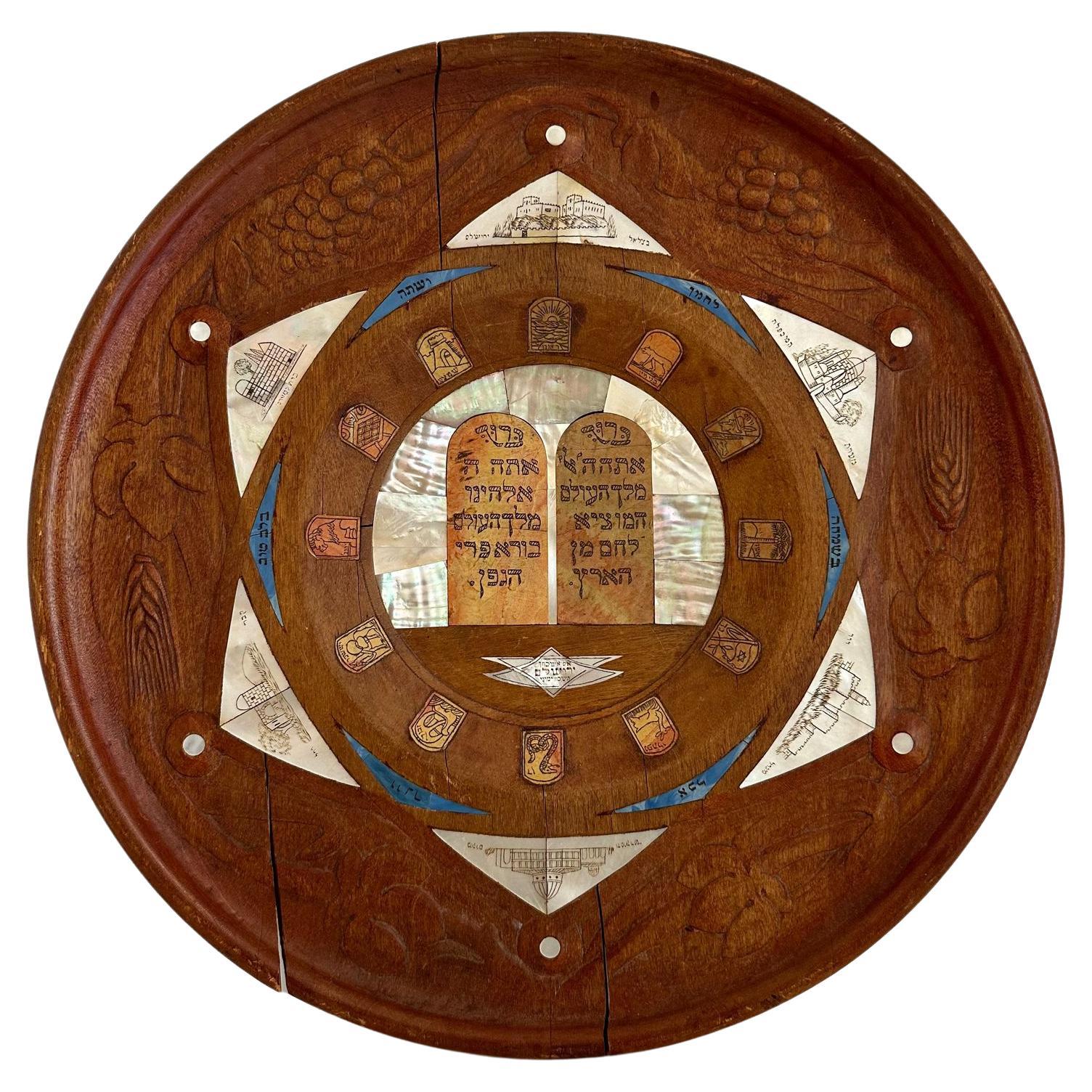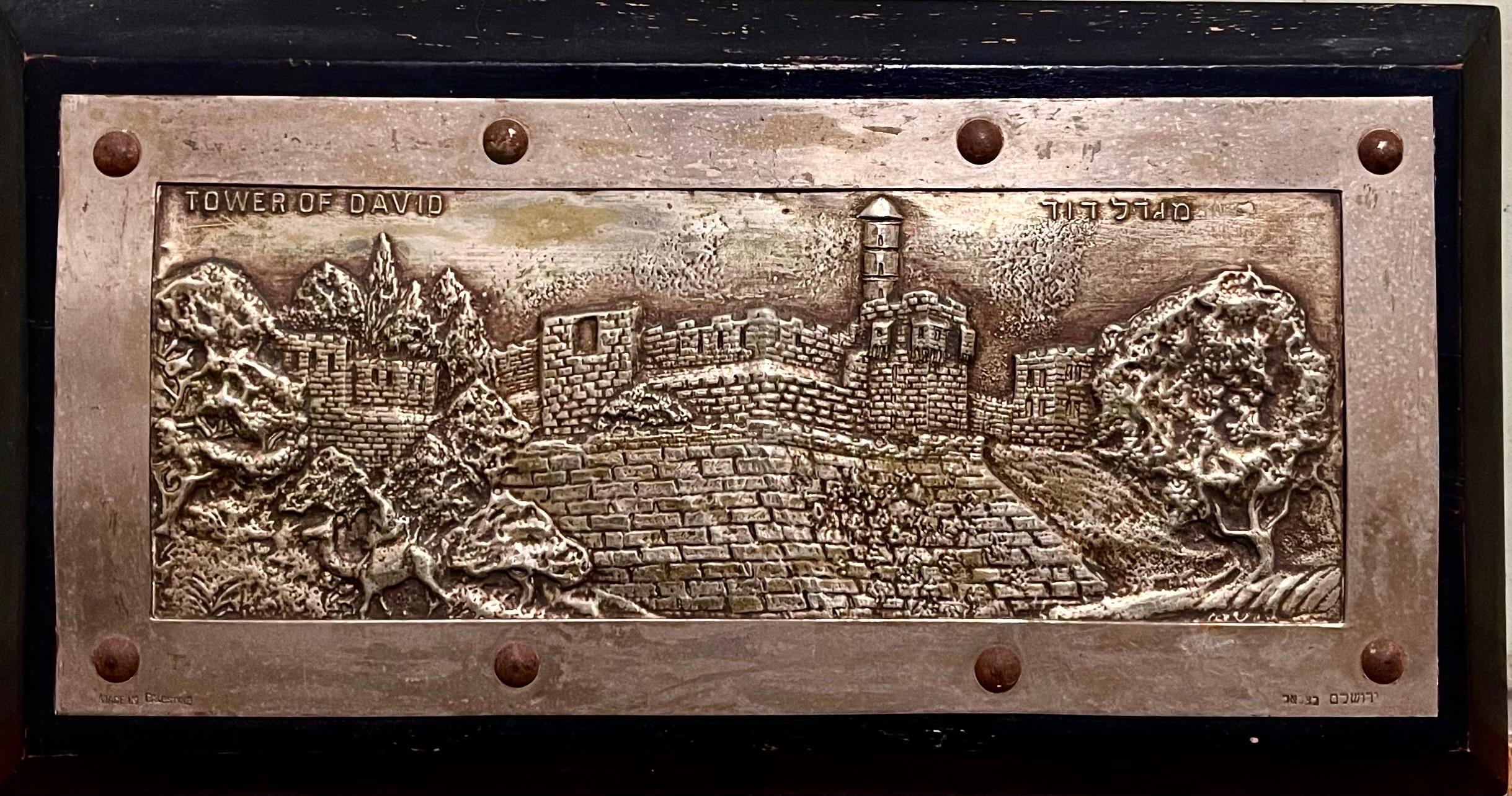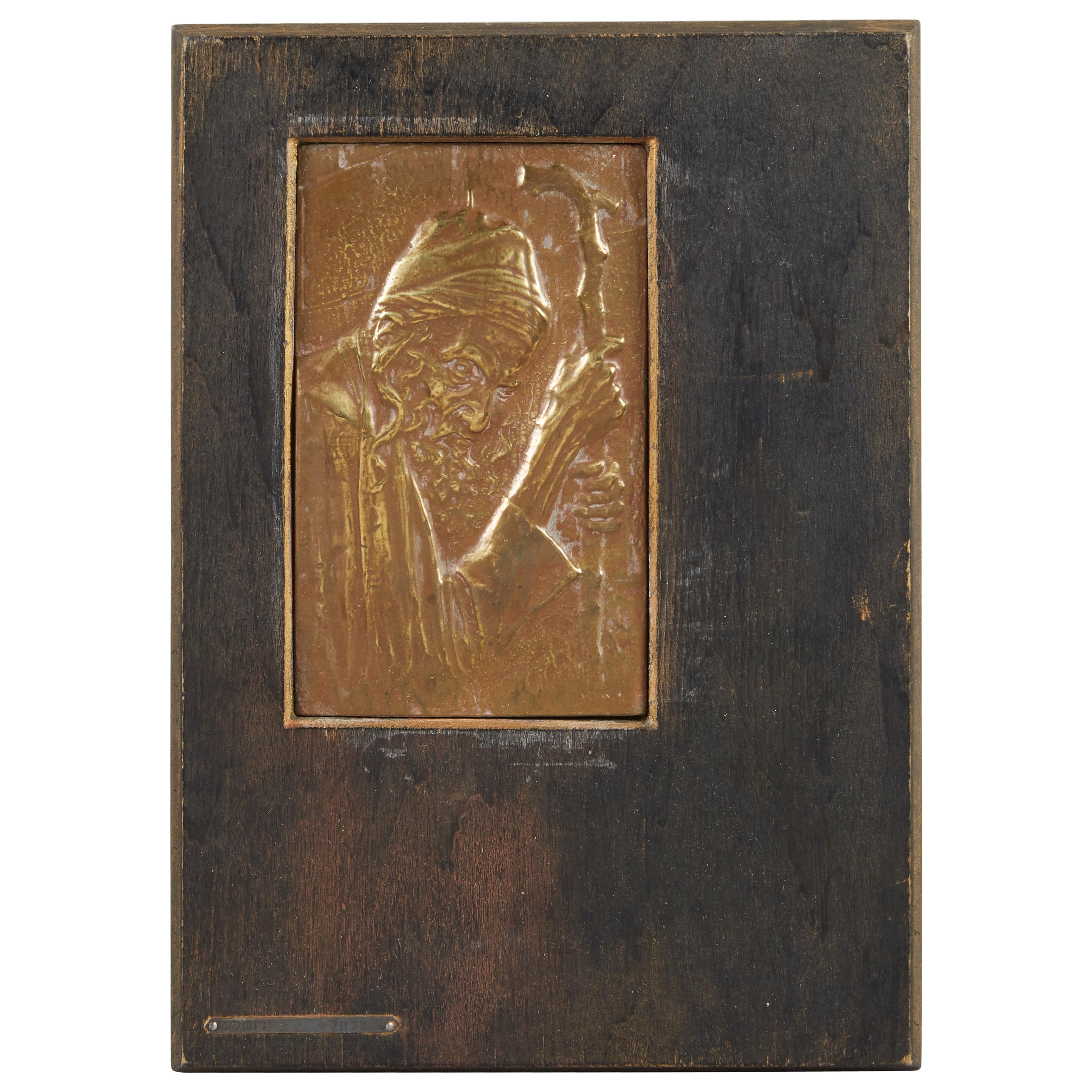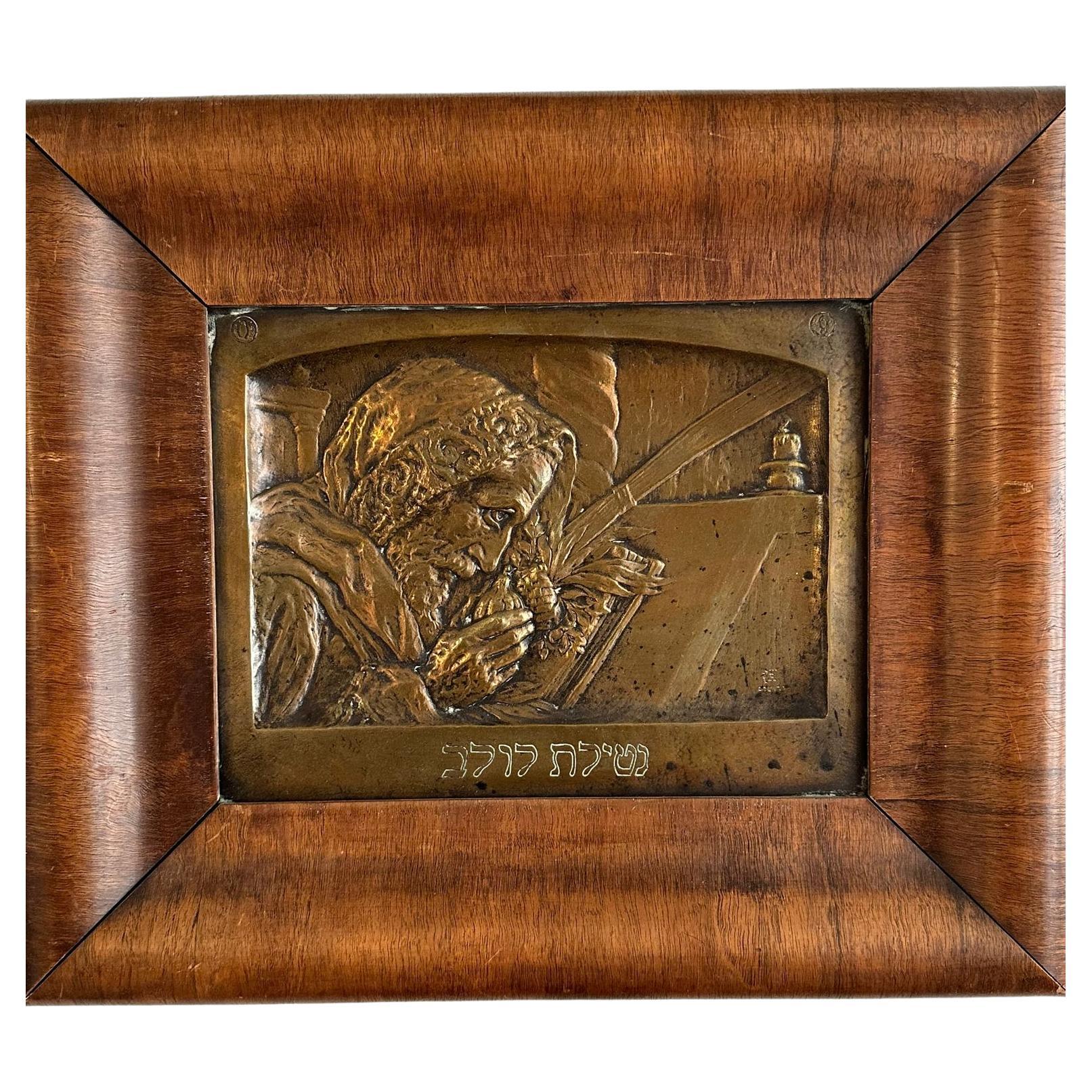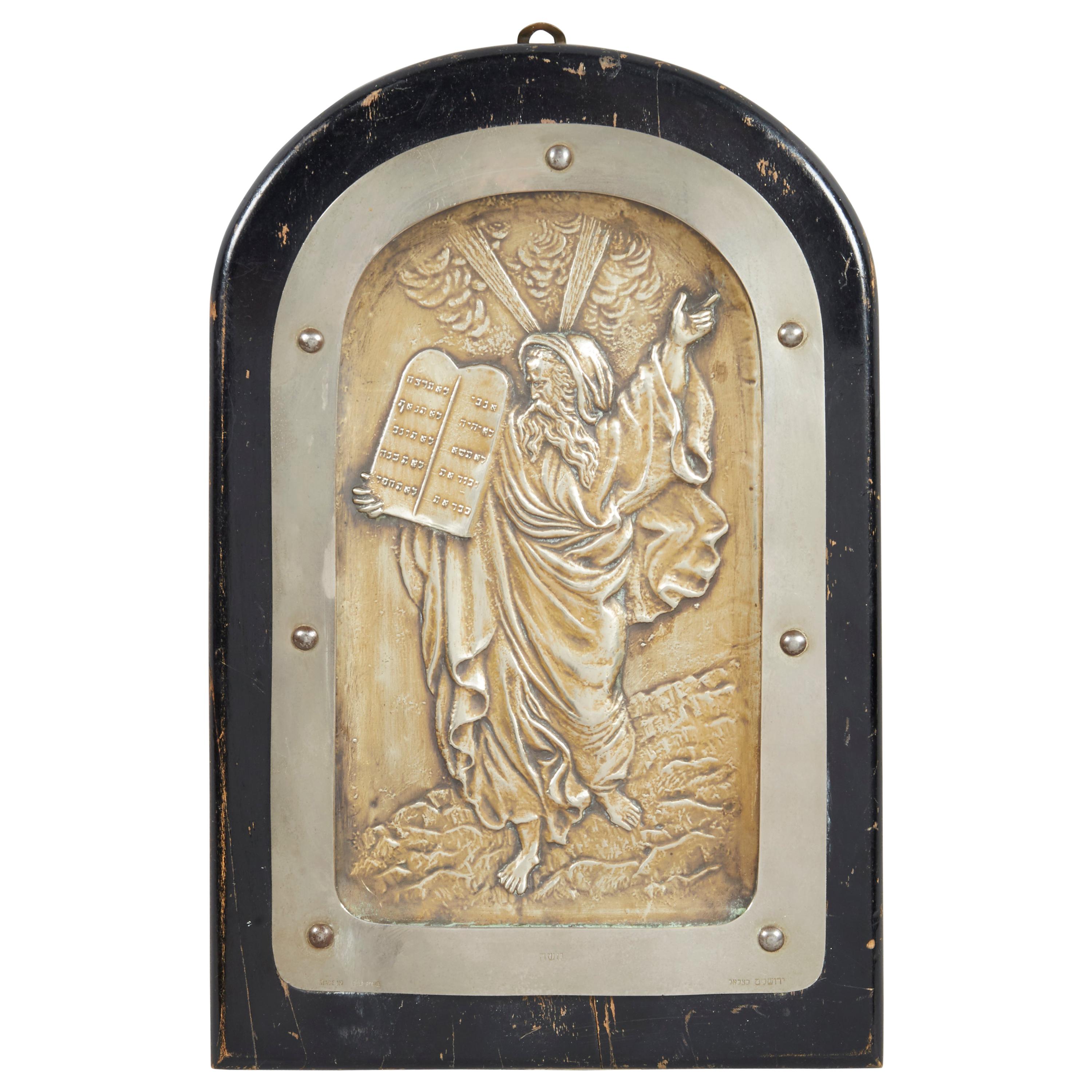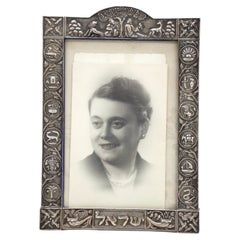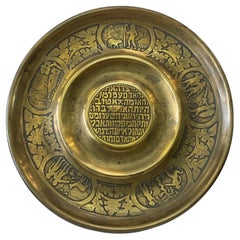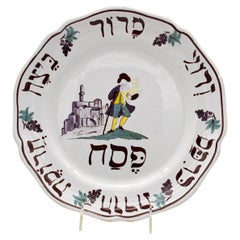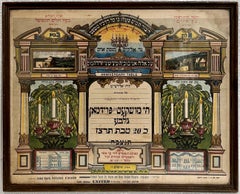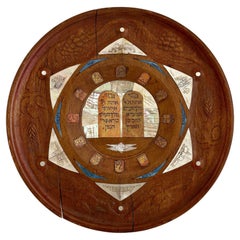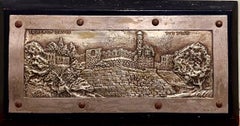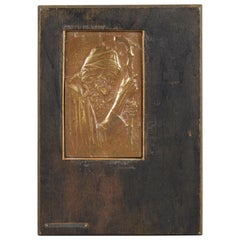Items Similar to Historic Rare Carved memorial plaque made by Jewish internee in Cyprus, 1948
Want more images or videos?
Request additional images or videos from the seller
1 of 21
Historic Rare Carved memorial plaque made by Jewish internee in Cyprus, 1948
$4,800
£3,669.86
€4,226.93
CA$6,726.27
A$7,509.25
CHF 3,934.73
MX$91,920.59
NOK 49,971.16
SEK 47,116.46
DKK 31,546.03
Shipping
Retrieving quote...The 1stDibs Promise:
Authenticity Guarantee,
Money-Back Guarantee,
24-Hour Cancellation
About the Item
super rare and historic example of Cyprus stone carving, made by jewish holocaust surviver that was Detained at the Internment camps in Cyprus, just 3 years after the holocaust. this piece is very unusual, most of this carvings shows us aspects of living in the Refugee camps or zionist views of israel, sometimes they even made judaica objects like menorahs Or Candlesticks, but its rare to find memorial plaques such as the example in front of us, the plaques was Damaged In the way to israel and two pieces from the upper section were broken off, the middle part of the Plaque shows a Scroll shaped memorial plaque with the inscription : "for the dead who died on the name of god" In red color, the middle has a yellow star carved and painted, just like the yellow star jewish people were forced to Wear on the holocaust, under this inscription there are 5 yiddish names and near them the passing dates, first 3 Has the exact dates but the last two has just the name of the hebrew month (most of the survivors did not know There family members exact date of death in the holocaust) .
the back side has a scratched inscription in hebrew "cyprus 1948" in hebrew ״קפריסין 1948״
On the right side there is a carved candle on top a carving which is now missing and was broken off. The most important and touching part of this plaque is the lower part:
On the right there is a writhing in hebrew that says "past" ״עבר״ and the carving of a crematorium with an electric Fence in the background, the crematorium looks exactly like the one that was used in the Buchenwald death Camp so maybe the carver made it from his memory, on the top of the building there is a big chimney and from it There is a big smoke line going out, inside this smoke there is the number 6000000, for the six million jewish lives Murdered by the nazis in the holocaust. (this is one of the earliest depictions of this number, we know now that the Number was set around 1945, just at the end of the war)
In the middle carving it is written "present" ״הוה״ and we can see the actuall cyprus internment camp, there is a small hut or a tin building and a big guard tower on top, its important to see that the fence is conecated to the fence of the death camp to the right, this shows us that the people held in the camp by the british army felt like they are moving from one camp to the next one.
the last carving says "future" ״עתיד״ and there we can see the plowed field and a house on a hill, with some trees and again a tower, but this time the tower is a water tower, which Symbolize life, the first tower was the chimney that took part in the murder of our people, the second tower was used by the english army to keep us far from our home last ISRAEL, but the last tower is a water tower, which gives life and his built on top of the plowed hill of what look like a kibbutz.
condition is like stated, the plaque is in its original found condition, upper part is missing, some defects to the remaining part, a latter is missing to the lower section, a lot of scratches. but this artifact came from a very hard time in history and every scare on it brings us a part of history, museum quality object.
Size :
Height : cm: 18.5 / inch 7.2
Width : cm: 15 cm / 5.9 inch
As waves of refugees from World War II made their way to the Land of Israel, the British were forced to find a solution for the influx of immigrants. The detention camp in Atlit was filled to capacity. As a result, additional camps were built in Cyprus, also under British control at the time, in 1946 and 1949. There, tens of thousands of Jews awaited government approval to enter the Land of Israel. A dream, which would eventually come true.
The Cyprus internment camps were camps maintained in CYPRUS by the British government for the INTERNMENT of JEWS who had immigrated or attempted to immigrate to MANDATORY palesting in violation of British policy. There were a total of 12 camps, which operated from August 1946 to January 1949, and in total held 53,510 Jews.
The British understood that they could not treat the Jewish refugees as ordinary prisoners and, therefore, allowed the detainees a certain level of autonomy. With the help of large donations from the Land of Israel and Jews across the world, the Jewish leaders in the camps tried to create a semblance of normal life for the refugees. Part of setting up this new order was the creation of jobs and societal roles within the camps.
Within the confines of the barbed-wire fences, cultural, welfare, educational and religious activities were established and organized in an attempt to recreate routine, daily life. Naturally, nurturing the children of the camp was at the center of community priorities and values.
An expression of what life was like in the camp for the children which also tells us something about their mindset, can be seen in this stone carving. There was no shortage of stone available in the Cyprus camps, and it was soon utilized in the children’s educational frameworks, which included the art of stone carving.
- Dimensions:Height: 7.2 in (18.29 cm)Width: 5.9 in (14.99 cm)Depth: 0.8 in (2.04 cm)
- Materials and Techniques:
- Place of Origin:Cyprus
- Period:
- Date of Manufacture:1948
- Condition:Wear consistent with age and use. the plaque is in its original found condition, upper part is missing, some defects to the remaining part, a latter is missing to the lower section, a lot of scratches. but this artifact came from a very hard time and every scare is part of history.
- Seller Location:Tel Aviv - Jaffa, IL
- Reference Number:1stDibs: LU8130238063762
About the Seller
No Reviews Yet
Vetted Professional Seller
Every seller passes strict standards for authenticity and reliability
1stDibs seller since 2023
- ShippingRetrieving quote...Shipping from: Tel Aviv - Jaffa, Israel
- Return Policy
Authenticity Guarantee
In the unlikely event there’s an issue with an item’s authenticity, contact us within 1 year for a full refund. DetailsMoney-Back Guarantee
If your item is not as described, is damaged in transit, or does not arrive, contact us within 7 days for a full refund. Details24-Hour Cancellation
You have a 24-hour grace period in which to reconsider your purchase, with no questions asked.Vetted Professional Sellers
Our world-class sellers must adhere to strict standards for service and quality, maintaining the integrity of our listings.Price-Match Guarantee
If you find that a seller listed the same item for a lower price elsewhere, we’ll match it.Trusted Global Delivery
Our best-in-class carrier network provides specialized shipping options worldwide, including custom delivery.More From This Seller
View Allrare Silver picture frame, Bezalel School Jerusalem, Zeev Raban, Israel, Jewish
Located in Tel Aviv - Jaffa, IL
This is an important and super rare picture frame, all hand made from silver, by the way the work was done and by the design it was hand made by Zeev Raban, in the last picture you c...
Category
20th Century Israeli Jugendstil Picture Frames
Materials
Silver
Important 18th century Persian Jewish silver Amulet for mother and newborn
Located in Tel Aviv - Jaffa, IL
Mysterious Amazing, 18th century silver talismanic amulet, Amulet for mother and Newborn with image of Lilith in the center made by Jews in Persia, the top of the Amulet has an amazi...
Category
Antique 1790s Tribal Art
Materials
Agate, Silver
Rare early Bezalel Jerusalem JUDAICA etched brass garden of eden plate
Located in Tel Aviv - Jaffa, IL
very rare Bezalel Jerusalem plate , this amazing plate has the best subject And artistic Design i have seen in a lot of years, the plate has 5 different scenes from the story Of Adam And Eve in the garden pf Eden.
On the middle of the plate the is an Hebrew inscription, it is parts from the 5 lines that describe The 5 scene on the plate:
"וַיִּ֩יצֶר֩ אֶת־הָֽאָדָ֗ם עָפָר֙ מִן־הָ֣אֲדָמָ֔ה"
"And the Lord God formed man of dust from the ground"
"לֹא־ט֛וֹב הֱי֥וֹת הָֽאָדָ֖ם לְבַדּ֑וֹ"
"And the Lord God said, "It is not good that man is alone"
"'וַיִּֽהְי֤וּ שְׁנֵיהֶם֙ עֲרוּמִּ֔ים"
"Now they were both naked"
"וַתִּקַּ֥ח מִפִּרְי֖וֹ וַתֹּאכַ֑ל וַתִּתֵּ֧ן גַּם־לְאִישָׁ֛הּ"
"She took of its fruit, and she ate, and she gave also to her husband"
"וַיְגָ֖רֶשׁ אֶת־הָֽאָדָ֑ם וַיַּשְׁכֵּן֩ מִקֶּ֨דֶם לְגַן־עֵ֜דֶן אֶת־הַכְּרֻבִ֗ים וְאֵ֨ת לַ֤הַט הַחֶ֨רֶב֙ הַמִּתְהַפֶּ֔כֶת לִשְׁמֹ֕ר אֶת־דֶּ֖רֶךְ עֵ֥ץ הַֽחַיִּֽים:"
"And He drove the man out, and He stationed from the east of the Garden of Eden the cherubim and the blade of the revolving sword, to guard the way to the Tree of Life."
This rare plate is fully marked on the back "BEZALEL JERUSALEM" in Hebrew, the Jerusalem Mark is a bit worn but it is present, on the top of the mark there is the number 522 which is Probably the model number, this plate was mad on the early 1910s or even earlier and it is one of Bezalel earliest works, it is not known who is the artist but the artistic style is typical of Reuben Leaf Lipschitz, he was working in Bezalel in 1912-1916 and was the manager of the etching Department in this time frame, in 1916 he moved to the USA to escape joining the ottoman army in ww1. he stayed in the USA and became a graphic designer who designed and decorated Synagogues he also made graphic designs a illustrations to Hebrew books...
Category
Vintage 1910s Israeli Arts and Crafts Decorative Dishes and Vide-Poche
Materials
Brass
French faience Passover plate, JUDAICA 19th century
Located in Tel Aviv - Jaffa, IL
this plate has a creme white background, the center painted with a man holding a lamb before a cityscape, probably a depiction of Jerusalem by someone who never actually visited the city or even see it, under the man there is the word Passover "פסח" the rim with the order of the Seder, and some grape vines between them.
Passover, also called Pesach ( Biblical Hebrew: חַג הַפֶּסַח, romanized: Ḥag haPesaḥ), is a major Jewish holiday, one of the three pilgrimage festivals, that celebrates the Biblical story of the Israelites' escape from slavery in Egypt.
Pesach starts on the 15th day of the Hebrew month of Nisan which is considered the first month of the Hebrew year. The Hebrew calendar...
Category
Antique Late 19th Century French Victorian Platters and Serveware
Materials
Pottery
Russian silver torah shield, judaica, Michael Karpinsky, Saint Petersburg, 1835
Located in Tel Aviv - Jaffa, IL
Rare and exceptional example of early russian Judaica, this torah shield or tas is made From 84 silver, has the marks of the city of saint Petersburg, together with the makers Mark of Michael Karpinsky and the date of 1835, Judaica objects from Russia is very rare, Especially from this early date, saint Petersburg jewish community was very small Because of the Jewish settlement was largely restricted. Under Tsar Alexander II upper Class Jews fitting certain criteria were allowed to live in the city, and many other Jews Who did not fit these categories settled illegally.
This was is decorated with two flanking lions with the two tablets of stone on which the Ten Commandments were engraved on, the 10 commandments are engraved in Hebrew On this example as long as the two words "torah" and "crown" on the two sides.
On the lower part there is the inscription with the donors name which is "Dina Whitenbarch" in Hebrew. the silver work on this was is just exceptional and deep.
The crown on the top of the lions is the Russian crown.
The back part has two welded silver loops used for hanging the shield on the torah.
Measurements :
Height : 23 cm / 9 inch
Width : 19 cm / 7.4
Jews of saint Petersburg:
The history of the Jews in Saint Petersburg (formerly known as Petrograd and then Leningrad) dates back to the 18th century and there is still a Jewish community in the city Today...
Category
Antique 1830s Russian Neoclassical Revival Sterling Silver
Materials
Silver
Decorative Judaica Passover plate by Heinrich Schwed. Munich, 1924.
Located in Tel Aviv - Jaffa, IL
Decorative Passover plate by Heinrich Schwed. Munich, 1924.
ALPACA, etched.
This Large plate, featuring a round medallion in the center, with a Matzah which in this plate is hand c...
Category
Vintage 1920s Platters and Serveware
Materials
Alpaca
You May Also Like
Rare Palestine Antique Hebrew Judaica Yahrzeit Synagogue Sign Memorial Plaque
Located in Surfside, FL
Circa 1890-1920. This Neoclassical, Judaic, Egyptian revival, Orientalist Mizrach sign, was produced in British Mandate Palestine by the chromolithograph process at the beginning of the 20th century. It pictures vignettes of holy places. with a hand written memorial. It was for the Tzedakah charity fund for the century-old institutions in Jerusalem: The great "Torah Center Etz Chaim"; a Free Kitchen for poor children and orphans; the famous Bikur Cholim Hospital with its dispensaries and clinics and the only Home for Incurable Invalids in Eretz Israel. They also worked with Arthur Szyk and Alfred Salzmann.. The A.L. Monsohn Lithographic Press (Monzon Press, Monson Press, דפוס אבן א"ל מאנזאהן, דפוס מונזון) was established in Jerusalem in 1892 by Abraham-Leib (or Avrom-Leyb) Monsohn II (Jerusalem, c.1871-1930) and his brother Moshe-Mordechai (Meyshe-Mordkhe). Sponsored by members of the Hamburger family, the brothers had been sent to Frankfurt, Germany in 1890 to study lithography. Upon returning to Jerusalem in 1892 with a hand press, they established the A.L. Monsohn Lithographic Press in the Old City of Jerusalem. According to the Information Center for Israeli Art A.L. Monsohn "created complex decorations for documents and oriental calendars that combined the tradition of Jewish art with modern printing techniques such as photographic lithography, raised printing and gilding."
The founders of the Monsohn press produced Jewish-themed color postcards, greeting cards, Jewish National Fund stamps, and maps documenting the evolution of the Jewish settlement in Eretz Israel in the nineteenth-twentieth centuries; religious material such as decorative plaques for synagogues, portraits of Old Yishuv rabbis such as Shmuel Salant, Mizrah posters indicating the direction of prayer for synagogues, memorial posters, and posters for Sukkot booths; color frontispieces for books such as Pentateuch volumes and the early song collections of Abraham Zvi Idelsohn (e.g., Shire Zion, Jerusalem 1908); artistic wedding invitations; and labels, packaging and advertisements for the pioneering entrepreneurs of Eretz Israel. The texts appearing in the Monsohn products were in several languages: Hebrew, Arabic, Yiddish, English, German (e.g., a c1920 trilingual Hebrew-English-Arabic "Malaria Danger" broadside warning the public of mosquitoes spreading malaria). Many of the brilliantly colored postcards and maps can be seen online as can the artistic invitations to his children's weddings which Monsohn published in the Jerusalem Hebrew press.
For years, the Monsohn (later, Monson/Monzon) Press was considered the best and most innovative in the country—pioneering in such techniques as gold-embossing and offset printing, among others. Early items for tourists included collections of Flowers of the Holy Land (c. 1910–1918)—pressed local flowers accompanied by scenes from the Eretz Israel countryside and relevant verses from the Bible, edited by Jsac Chagise (or Itzhak Haggis), an immigrant from Vitebsk, and bound in carved olive wood boards. Shortly after World War I Monsohn (now spelled מונזון) used zincography to produce the prints included in the Hebrew Gannenu educational booklets for young children illustrated by Ze'ev Raban of the Bezalel Academy of Art and Design and printed in Jerusalem by Hayim Refael Hakohen (vol. 1, 1919; vols. 2–3, 1920). In 1934 Monsohn moved into the new, western part of Jerusalem, in a shop with four presses and 30 workers, including Abraham-Leib's sons, David, Yosef, Moshe and Shimon, and his daughter Raytse's husband, Abraham Barmacz. The concern did business with all sectors of the city's population, including Arabs, for whom they printed in Arabic. Among their clients were members of the Ginio, Havilio, and Elite families, and Shemen, Dubek, and other renowned national brands, manufacturing products such as wine, candies, oil, and cigarettes. They also printed movie and travel posters, and government posters, postcards and documents, hotel luggage labels...
Category
Early 20th Century Aesthetic Movement More Art
Materials
Lithograph
Early 20th Century Bezalel Jerusalem Shabbat Tray
Located in New York, NY
Early 20th century Bezalel Jerusalem wooden tray inlaid with Jerusalem stone and mother of pearl.
The large tray is carved with the Seven Species on its...
Category
Early 20th Century Israeli Folk Art Religious Items
Materials
Marble
$15,000 Sale Price
20% Off
Vintage Jerusalem Sculpture Wall Plaque 1930's Palestine Israeli Bezalel School
Located in Surfside, FL
Repousse sculptural plaque from the original Bezalel Art School in Jerusalem.
This is marked "Made in Palestine" as it is from the British Mandate period. It is in an Orientalist des...
Category
20th Century Modern More Art
Materials
Metal
Early 20th Century Brass Plaque by Bezalel School Jerusalem
Located in New York, NY
Bezalel brass plaque depicting a Jewish elder next to the Western Wall, made in Jerusalem, circa 1920, bearing a small metal label engraved "Bezalel Jeru...
Category
Early 20th Century Israeli Decorative Art
Materials
Brass
$960 Sale Price
20% Off
Early 20th Century "Netilat Lulav" Bronze Plaque by Boris Schatz, Bezalel
Located in New York, NY
Massive bronze plaque depicting the act of "Netilat Lulav" that takes place during the Jewish holiday of Sukkot. The plaque was made and signed by Boris Schatz, who was part of the B...
Category
Early 20th Century Israeli Neoclassical Wall-mounted Sculptures
Materials
Bronze
$6,800 Sale Price
20% Off
Early 20th Century Silver Plate Plaque by Bezalel School Jerusalem
Located in New York, NY
Bezalel silver plate plaque depicting Moses at Mount Sinai, made in Jerusalem, circa 1925, marked "Bezalel Jerushalem" in Hebrew and "Made in Palestine,...
Category
Early 20th Century Israeli Decorative Art
Materials
Silver Plate
$720 Sale Price
20% Off
More Ways To Browse
Jewish Furniture
Hand Carved Plaque
Cyprus Furniture
Tree Of Life Folk Art
Jewish Menorah
Menorah Used
English Watering Can
Hand Carved Israel
Judaica Menorah
Soapstone Used
Judaica Candle
Large Menorah
Vintage Electric Candles
Stone Menorah
Ktas Antique Phone
Piggin Bucket
Scrimshaw Walking Stick
Ancient Roman Dice
